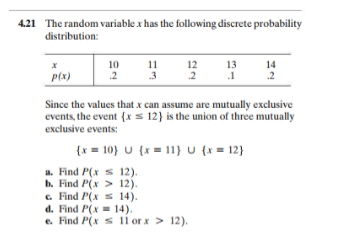4.21 The random variable x has the following discrete probability distribution: 10 11 12 13 14 P(x) 2 2 Since the values that x can assume are mutually exclusive events, the event {xs 12} is the union of three mutually exclusive events: {x = 10} U {x = 11}U {x = 12} a. Find P(x s 12) h. Find P(x > 12). End P .< 14Y 어
4.21 The random variable x has the following discrete probability distribution: 10 11 12 13 14 P(x) 2 2 Since the values that x can assume are mutually exclusive events, the event {xs 12} is the union of three mutually exclusive events: {x = 10} U {x = 11}U {x = 12} a. Find P(x s 12) h. Find P(x > 12). End P .< 14Y 어
Algebra & Trigonometry with Analytic Geometry
13th Edition
ISBN:9781133382119
Author:Swokowski
Publisher:Swokowski
Chapter10: Sequences, Series, And Probability
Section10.8: Probability
Problem 31E
Related questions
Question
100%

Transcribed Image Text:4.21 The random variable x has the following discrete probability
distribution:
10
11
12
13
14
P(x)
.2
3
2
.1
.2
Since the values that x can assume are mutually exclusive
events, the event {x s 12} is the union of three mutually
exclusive events:
{x = 10} U {x = 11} u {x = 12}
a. Find P(x s 12).
b. Find P(x > 12).
c. Find P(x s 14).
d. Find P(x = 14).
e. Find P(x s 11 or x > 12).
Expert Solution
This question has been solved!
Explore an expertly crafted, step-by-step solution for a thorough understanding of key concepts.
This is a popular solution!
Trending now
This is a popular solution!
Step by step
Solved in 2 steps

Recommended textbooks for you

Algebra & Trigonometry with Analytic Geometry
Algebra
ISBN:
9781133382119
Author:
Swokowski
Publisher:
Cengage

Algebra & Trigonometry with Analytic Geometry
Algebra
ISBN:
9781133382119
Author:
Swokowski
Publisher:
Cengage